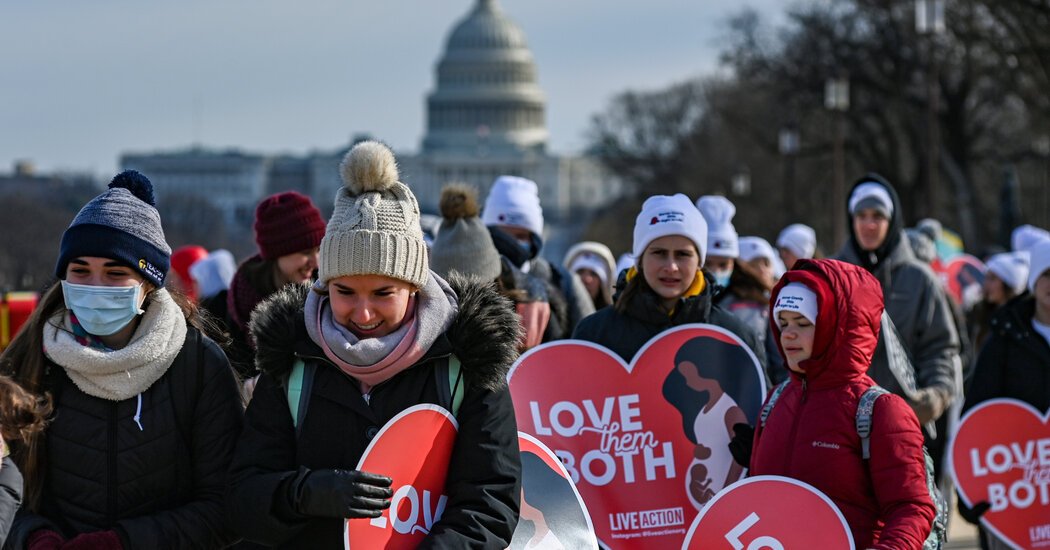How U.S. Abortion Law Compares With Other Nations – The New York Times
Advertisement
Supported by
Many rich democracies have earlier cutoffs for abortion — but allow it later for a variety of reasons. And around the world, it has been much more common to expand access than restrict it.
Send any friend a story
As a subscriber, you have 10 gift articles to give each month. Anyone can read what you share.
By Claire Cain Miller and Margot Sanger-Katz
Chief Justice John G. Roberts Jr. said last month that the United States was an international outlier in allowing abortion more than halfway through pregnancy. That later cutoff, he said, places the United States in the company of North Korea and China.
It’s true in some ways, but not all. Few countries allow abortion without restriction until fetal viability, the cutoff set by Roe v. Wade, which was decided 49 years ago today. Because of medical advances, that is now around 23 weeks. And only around a dozen other countries allow abortions for any reason beyond 15 weeks of pregnancy, the threshold in the Mississippi law the Supreme Court is considering, which could overturn Roe.
But in many countries, women can get an abortion after the gestational cutoff — for a wide variety of reasons, like health or economic ones. In some, it can be easier to obtain an abortion than in many parts of the U.S. Also, peer countries tend to have more abortion providers, and cover the costs of abortions.
“Under the status quo, abortion access is still out of reach for many in the United States,” said Risa Kaufman, director of U.S. human rights at the Center for Reproductive Rights, which fights abortion restrictions in American courts and tracks international laws. “That is in contrast to many countries, including in Western Europe, that provide access to subsidized, fully funded abortion services, universal health care, contraception and broader social supports.”
The United States is an outlier in another way — by considering rolling back abortion access. The Mississippi case is a direct challenge to Roe. If the court overturns Roe, more than 20 states are expected to ban or severely limit abortion at all stages of pregnancy.
Just three countries have tightened abortion laws since 1994, according to the center: Poland, El Salvador and Nicaragua. In that period, 59 have expanded them. In 2018, Ireland, which had mostly banned abortion, made it legal on request until 12 weeks. Other countries, like South Korea, have decriminalized it.
“The U.S. trend is very much the minority trend,” said Joanna Mishtal, an anthropologist at the University of Central Florida who studies reproductive rights policies in Europe. She said Poland is the only European nation “that is consistently restricting both policies and real access to services that are still lawful.”
Worldwide, six in 10 women of reproductive age live in countries that broadly allow abortion, according to the Center for Reproductive Rights.
Sixty-six countries, home to just over a quarter of women of reproductive age, either prohibit abortion or allow it only if a woman’s life is danger, according to the center’s data on national laws that have been formally adopted.
Sixty-three countries, representing 35 percent of women of reproductive age, allow abortion for various reasons, including protection of a woman’s physical or mental health or consideration of her social or economic circumstances.
Some countries in this group are more permissive than others. In Britain, women must have two doctors approve their abortion, but requests are routinely granted up to 24 weeks — and beyond that for severe health reasons. (The National Health Service website says: “The decision to have an abortion is yours alone.”) In Bolivia, however, a woman must show a grave health risk from her pregnancy, or show it was a result of rape or incest.
Seventy-four countries, home to 38 percent of women, allow abortion for any reason for a certain number of weeks. The most common threshold is 12 weeks. A dozen or so countries besides the United States allow abortion without any restrictions or conditions after 15 weeks, the cutoff in question in the Mississippi case. They include North Korea, China, Iceland, New Zealand, Singapore, Canada and Vietnam.
“Through the lens of comparative national law, Mississippi’s abortion regime is more permissive than in most countries,” wrote 141 international legal scholars in a brief to the Supreme Court in support of Mississippi.
Some of these countries, however, allow abortion after the cutoff if the woman has a valid reason, and law scholars say that in some of them, abortion until fetal viability is as accessible as it is in the United States.
In Germany, for example, abortion is permitted on request until 12 weeks, and until 22 weeks if, in the woman’s view, it is necessary for her physical or mental health or for present or future living conditions. In Denmark, which also has a 12-week cutoff, abortion is allowed after that time for factors including health; the person’s age, income or housing; or her interests or occupation.
Other countries also allow exceptions after 12 weeks, but they are less broad. In France and Ireland, for instance, the exceptions are to prevent serious health issues or death, or if the fetus has a severe, incurable illness.
Gestational cutoffs, even if they have exemptions, can present obstacles to abortion access. One strong piece of evidence is the large number of women who travel to less restrictive countries in Europe for later abortions, Professor Mishtal said.
“Gestational age limits are serious barriers,” she said. “Even in places that are ostensibly liberal, that limit creates a real barrier to the people who need the service beyond that limit.”
In the United States, only about 8 percent of abortions happen after 13 weeks. One reason some women have later abortions is because of barriers in the U.S. It takes time to save money for the procedure — or to arrange transportation, child care and time off work to travel to a clinic if there is not one nearby.
In much of Europe, abortion laws may be more permissive than they appear on paper. But in other parts of the world, there is less access to abortion than the law permits. In sub-Saharan Africa, most countries ban abortion, but even those that say they allow it, like South Africa, have limited access.
“Access to safe and affordable services in government hospitals can also be limited by a scarcity of health professionals that are trained to provide these legal abortions or have limited knowledge about abortion law,” said Siri Suh, a medical sociologist at Brandeis University who has researched reproductive health in Africa.
Abortion in Italy is broadly legal and free, but nearly three-quarters of doctors there have registered as conscientious objectors, and are exempted from performing abortions for religious or moral reasons. Other doctors feel pressure from colleagues not to provide abortions, Professor Mishtal and colleagues found. “It has a chilling effect,” she said. “There is an enormous discrepancy between the law and the actual access.”
In other rich democracies, abortion is covered by public health insurance. So are other forms of reproductive health care, including contraception. In Ireland, for example, the cost of an abortion is fully covered, the procedure can be performed by a general practitioner, and there is a government help line on how to get an abortion or reach a nurse during recovery.
The United States prohibits federal funding of abortions in most cases. Also, abortions tend to be provided only in special clinics, often far from where women live. In peer nations, they are more likely to be offered at ordinary hospitals and medical clinics.
Most European countries have arrived at their abortion laws through legislation involving political compromise. In the U.S., the viability threshold originated in the Supreme Court. Michael New, a law professor at the Catholic University of America who supports more U.S. restrictions on abortion, said this process difference may explain why the gestational limit in U.S. law is later than in most of its peer nations.
“A legal debate, built upon precedent, can be very different from a democratic debate or moral debate,” he said in an email.
The United States is also unusual in having such a wide range of laws by state, a feature that will be magnified if Roe is overturned. “In California, abortion access is fairly similar to abortion access in the United Kingdom, whereas in Texas right now, abortion access is really among the most restrictive in the world,” said Caitlin Gerdts, a vice president at Ibis Reproductive Health, a research group.
The very nature of illegal abortion worldwide is transforming because of the availability of pills that can end a pregnancy. Historically, countries without legal abortion tended to have high rates of unsafe abortion. But pills that cause abortions are safe and easy to transport. The most effective studied protocol involves two drugs. But just one, misoprostol, an ulcer drug on the World Health Organization’s list of “essential medicines,” causes a complete abortion in around 80 percent of cases or more, according to recent research.
In some countries, misoprostol is available over the counter at pharmacies. Activists in South America and Africa have increasingly helped women find and use the drug, outside the official health system. Groups in Europe provide online ordering of the pills, including to women in the United States, from pharmacies outside the country.
In a post-Roe world, states might seek to make such assistance, or the use of such pills, subject to punishment. In El Salvador, which prohibits abortion but has widespread use of misoprostol, women who experience miscarriages are sometimes jailed.
“The risks have also changed,” Ms. Gerdts said, “from physical to legal.”
Advertisement



